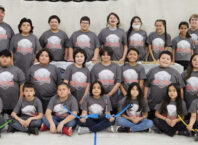By Lee Egerstrom
As January was giving way to February, Minnesota health providers and institutions were still under stress, the surge in COVID-19 and its Omicron variant infections was still underway, but new responses to the pandemic signaled help for Minnesota’s Native communities was on the way.
No guarantees that February will turn the corner on COVID. Another variant of Omicron is popping up globally and has now been diagnosed in California. That means it is only a matter of time before it will be found in Minnesota – with possible other variants to follow.
At the same time, several public and health-related steps started in Minnesota that can be of great importance to the Native American and other distinct communities in the state. Late January announcements included:
• Gov. Tim Walz announced that more than 200 nurses and respiratory therapists were coming to help Minnesota’s short-staffed hospitals cope with the continuing surge in COVID hospitalizations.
In separate late January emergency measures, federal help was bringing a fourth Defense Department medical team to the state to assist Abbott Northwestern Hospital in Minneapolis. It consists of 23 doctors, nurses and hospital staff who were to be assigned here for 30 days.
Previous federal medical teams shored up work at Hennepin County Medical Center, M Health Fairview Southdale Hospital and St. Cloud Hospital.
• The city of Minneapolis announced Jan. 28 it has received a two-year grant from the federal Centers for Disease Control and Prevention (CDC) for a program aimed at improving health and preventing chronic diseases within Black and Native American residents living in affordable high-rise apartments.
This is part of an ongoing effort to improve health and overcome health disparities for ethnic groups in high-rise public housing and through using culturally appropriate education. Stated goals include providing more access to nutritious, culturally specific foods; more access to preventive health care; more access to breastfeeding support for new mothers; and help managing high blood pressure, heart disease, Type 2 diabetes and unhealthy weight.
Sarah McKenzie, Minneapolis media relations coordinator, told The Circle the city’s primary partners from the Native American community include the Division of Indian Work and the Native American Community Clinic.
Funding comes from the CDC’s Racial and Ethnic Approaches to Community Health (REACH) program that assists state and local health departments, tribes, universities and community-based groups with both funds and expert support.
The Minneapolis REACH grant applications were developed with input from the Minneapolis American Indian Center, Dream of Wild Health and the Native American Community Development Institute.
This grant program will help the city and partners continue programs for residents in public housing. These services have already included providing thousands of COVID vaccinations at 39 public housing high rises, partnering with Hennepin Healthcare to provide booster shots for 564 residents, and help them access free COVID tests from the federal government.
• The Association of American Indian Physicians (AAIP) launched a nationwide campaign in early January to promote American Indian and Alaska Natives access to COVID and flu vaccination programs.
“I can’t think of a better way for AAIP to create and extend resources aimed at saving lives,” said Dr. Mary Owen, the Duluth doctor who is president of the national organization.
“Our elders are especially at risk because of the ongoing pandemic and flu season.
Vaccinations help save these special community members and thus preserve the cultures they represent and teach us so much about,” she said.
Owen is a Tlingit from Alaska, a University of Minnesota Medical School graduate, and currently serves as director of the Center of American Indian and Minority Health (CAIMH) at the University of Minnesota from the Duluth campus.
With this national campaign, AAIP has prepared and released several public service announcements (PSAs) that promote the importance for tribal members and everyone to get vaccinated.
These promotion pieces counter much of the disinformation that has traveled widespread through the Native American and other community groups that, in turn, leave the public vulnerable to the spread of the virus and the constantly mutating variant forms.
Dr. Owen and Dr. Arne Vanio, a prominent Cloquet doctor and member of the Mille Lacs Band of Ojibwe, are prominently featured in the public service announcement campaign.
The American Indian physicians group noted in its announcement of the vaccine campaign that American Indian and Alaska Natives are still disproportionately at risk of the virus, its Delta variant and subsequent sub-variants.
“Since September 2021, COVID-19 infection rates between racial groups have narrowed, however, (AIANs) remain the highest risk for COVID-19 related deaths,” the doctors stressed.
• Longer term, the University of Minnesota announced at month’s end that it is seeking design funds for a new academic health sciences center linking the UMD campus with Duluth’s medical complex. This comes in a University funding request to the Minnesota Legislature.
University officials explained in news reports that this expanded medical center would provide a larger healthcare workforce to service “Duluth, Greater Minnesota and the local Indigenous populations.”
These steps to combat COVID and encourage healthy living within Minnesota and its ethnic and racial communities come at a statistically confusing time here and across the nation.
Legal challenges are attempting to block state and federal mandates for people to be vaccinated to hold jobs where they are in contact with the general public and may endanger other people’s lives. Close to home, several small businesses – mostly bars and restaurants – are trying to keep Minneapolis from imposing its mandate that people going to events, bars and eateries must show they have been vaccinated or had recent negative COVID tests.
St. Paul has a similar mandate in place although it wasn’t under legal challenge at the time of this writing. There was disturbing news that the Ramsey County office most out of step with the county mandate for workers being vaccinated was the Ramsey County Sheriff’s Office.
As January came to an end, Minnesota was still averaging more than 30 deaths each day, there were 1,543 patients hospitalized with COVID variants, and 320 were in intensive care units. Minnesota Department of Health officials estimated there are 53,500 infected Minnesotans recovering from home.
COVID will be with us well into the new year … and perhaps longer.
The AAIP website can be accessed at: https://aaipvax.org.







